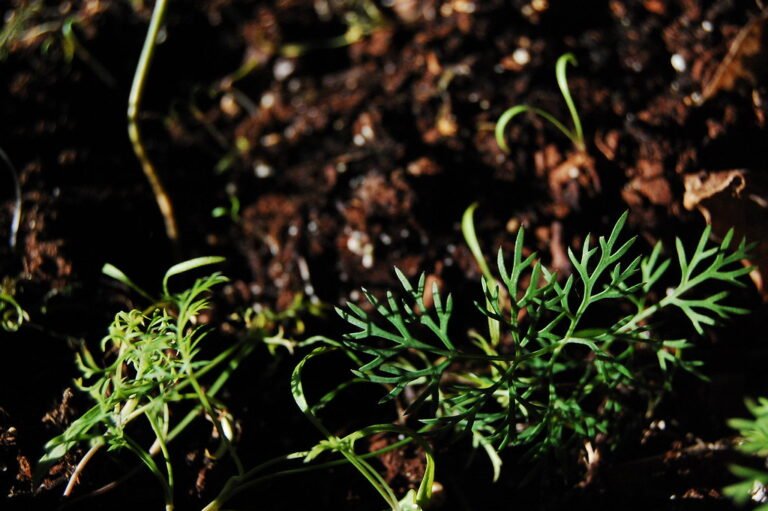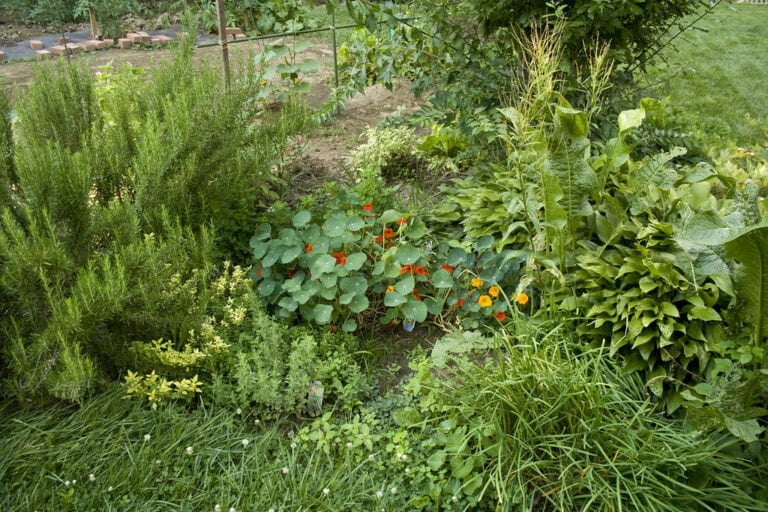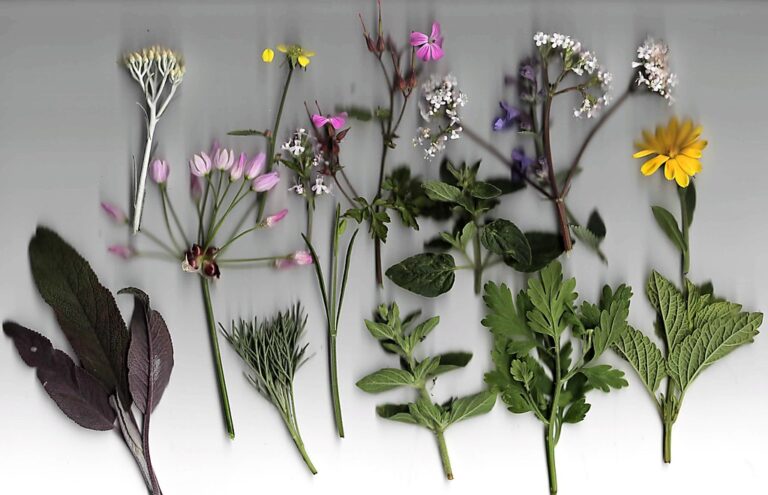Exploring the Benefits of Thyme as a Companion Plant
Thyme, a versatile herb in the garden, not only improves dishes but also acts as a natural pest control. It attracts beneficial insects and deters harmful pests like cabbage loopers and whiteflies. This makes it a valuable companion plant for a thriving ecosystem. Its aromatic flavors aren’t just for taste; they serve a purpose!
Thymes Role in Pest Control
Thyme actively repels a variety of pests and attracts beneficial insects, effectively contributing to natural pest management in the garden. As a vital pest repellent, thyme plays a pivotal role in deterring pests like cabbage loopers, maggots, corn earworm, tomato hornworm, and whiteflies. By planting thyme as a companion plant, it acts as a pest management system, reducing the need for chemical interventions.
One of the key advantages of thyme is its ability to attract beneficial insects that aid in pest control. These insects help in combating pests that attack plants such as eggplant, creating a balanced ecosystem in the garden. The presence of thyme not only deters harmful pests but also encourages the presence of insects that prey on them, promoting a healthier and more sustainable pest management approach.
When strategically placed alongside nightshades, tomatoes, Brassicas, strawberries, and potatoes, thyme improves the health and growth of these plants while simultaneously deterring pests. Its compatibility with a wide range of garden species, including blueberries, makes thyme a versatile companion for various crops, further aiding in pest management efforts. Additionally, in rose gardens, thyme’s ability to repel blackflies and aphids proves invaluable in reducing the presence of common pests, thus benefiting the overall health of the roses.
Thymes Culinary Uses and Health Benefits
Thyme is a culinary powerhouse, adding depth to dishes like soups, stews, meats, and veggies. Its rich flavor profile shines whether fresh or dried, making it a versatile herb in the kitchen. Packed with antioxidants and anti-inflammatory properties, thyme not only enriches taste but also amplifies the health benefits of your meals.
Culinary Versatility of Thyme
Elevating a variety of dishes with its savory and earthy flavor profile, thyme stands out as a versatile culinary herb known for its health benefits and aromatic presence in cooking. Thyme adds depth to soups, stews, meats, and vegetables, whether used fresh or dried. Its rich antioxidants and anti-inflammatory properties contribute to overall well-being. The herb’s aroma not only stimulates the senses but also enriches the overall culinary experience. With its ability to thrive with minimal care and its significant culinary value, thyme is an essential addition to any kitchen garden. Whether you’re looking to intensify the flavor of your dishes or reap the health benefits it offers, thyme’s culinary versatility makes it a must-have herb for every home cook.
Health Benefits of Thyme
Rich in antioxidants like thymol and packed with essential vitamins, thyme offers a myriad of health benefits beyond its culinary uses. Thyme’s antioxidants and antimicrobial properties can help combat infections, while its vitamins C, A, and K support immune function, skin health, and blood clotting. The essential oils present in thyme have anti-inflammatory properties that may promote respiratory health. Additionally, thyme has a history of use in traditional medicine for addressing coughs, sore throats, and digestive problems. By incorporating thyme into your diet or using it medicinally, you can harness these health benefits and boost your overall well-being.
Nutritional Value of Thyme
With its impressive array of essential nutrients and health-boosting properties, thyme proves to be a valuable addition to both culinary creations and overall wellness. Thyme is rich in vitamins C and A, iron, manganese, and fiber, making it a nutritious herb to incorporate into a balanced diet. Its antibacterial and antifungal properties not only support immune function but also help combat infections. In addition, thyme acts as a natural expectorant, aiding in respiratory health by relieving coughs and congestion. The herb’s antioxidants, such as thymol, carvacrol, and rosmarinic acid, work to reduce inflammation and oxidative stress in the body. Moreover, thyme’s essential oils have a history of traditional medicinal use for digestive issues, skin conditions, and promoting overall well-being.
Thymes Adaptability in Garden Environments
Thyme’s adaptability in garden environments is truly remarkable. This herb can thrive in various conditions, showcasing its versatility and resilience. From hot temperatures to drier soils, thyme remains a hardy plant choice for many gardeners.
Garden Versatility of Thyme
Adapting effortlessly to various garden environments, thyme proves its flexibility as a resilient perennial herb thriving in different conditions. Here are some key points highlighting the garden versatility of thyme:
- Adaptable to Various Conditions: Thyme is a versatile herb that can thrive in hot, dry, sandy, and rocky environments.
- Drought-Tolerant: This herb’s preference for well-drained soil and ability to withstand low water conditions make it suitable for xeriscaping.
- Soil Erosion Prevention: Thriving in arid regions, thyme aids in preventing soil erosion due to its ability to withstand hot temperatures.
- Pest Repellent Qualities: Thyme’s aromatic qualities not only boost the flavor of companion plants but also help repel pests like cabbage loopers and whiteflies.
Thymes Environmental Resilience
In garden environments, the flexibility and durability of thyme shine through its ability to thrive in various conditions, showcasing its environmental resilience. Thyme, part of the Lamiaceae family, is known for flourishing in hot temperatures and drier, sandier environments, making it a resilient herb in challenging garden settings. With over 300 varieties to choose from, thyme offers a wide range of options for companion planting, highlighting its adaptability. Its low-maintenance requirements and ability to boost the growth of other plants further demonstrate its resilience and usefulness in gardens. Additionally, the aromatic qualities of thyme not only benefit neighboring plants by strengthening their defenses but also add value to the garden, emphasizing its flexibility and practicality as a companion plant.
Thymes Garden Adaptability
Thyme shows remarkable flexibility in garden environments, highlighting its resilience and versatility in various growing conditions.
Thyme’s Garden Adaptability:
- Thyme thrives in hot temperatures and prefers well-drained, sandy soil.
- It is a robust, drought-tolerant perennial plant that can withstand hot climates.
- As a beneficial companion plant, thyme helps manage pests and boosts the growth of neighboring plants.
- Thyme flourishes in full sun exposure, making it an ideal addition to sunny garden spots.
Thyme’s low-maintenance nature and medicinal properties further enrich its value as a beneficial herb in the garden. Regular pruning and occasional fertilization can help sustain its growth, ensuring a thriving garden ecosystem.
Thymes Contribution to Ecosystem Balance
Contributing to ecosystem balance, thyme plays an essential role in attracting beneficial insects and aiding in soil erosion control. As a companion plant, thyme attracts a variety of beneficial insects such as honey bees, predatory wasps, and native pollinators. This attraction not only helps in pollination but also contributes to the overall biodiversity of the ecosystem. By repelling pests and providing a welcoming environment for these helpful insects, thyme assists in maintaining a natural balance within the garden ecosystem.
Thyme’s ability to prosper in rocky and arid areas makes it a valuable asset in controlling soil erosion, especially in challenging environments. Its robust nature, capable of withstanding drought and freezing temperatures, adds resilience to the ecosystem, promoting stability over time. Additionally, thyme’s talent for improving the flavor of companion plants like shallots and potatoes enhances the overall harmony within the ecosystem. This enrichment of flavors not only benefits human consumers but also aids in attracting more diverse species to the area, further enriching the ecosystem.
Thymes Aromatic and Medicinal Properties
With its aromatic and medicinal properties, thyme serves as a versatile herb that offers both sensory delight and therapeutic benefits. Here are some key points to understand the significance of thyme’s properties:
- Aromatic Properties: Thyme is renowned for its aromatic oils, which release a pleasant scent when the plant is touched or crushed. This fragrance not only adds to the sensory experience but also has practical applications in aromatherapy for relaxation and stress reduction.
- Medicinal Properties: Thyme contains compounds that exhibit antimicrobial and antioxidant effects. These properties make thyme a valuable herb for both culinary and therapeutic purposes. Its use in traditional medicine is well-documented due to its potential health benefits.
- Insect Repellent: The strong fragrance of thyme also acts as a natural insect repellent, making it an excellent companion plant in the garden. By planting thyme near other crops, you can help deter pests without the need for harmful chemicals.
- Culinary and Therapeutic Purposes: Thyme’s aromatic and medicinal properties make it a versatile ingredient in cooking, adding flavor and potential health benefits to dishes. Additionally, its therapeutic properties can be harnessed in teas, tinctures, and herbal remedies for various health conditions.
Thymes Harvesting and Maintenance Requirements
To maintain the vitality and productivity of thyme plants, it is important to understand the proper harvesting and maintenance techniques necessary for best growth. Harvesting thyme involves picking leaves that are starting to yellow and become limp, while cutting stems at a 45-degree angle can promote best regrowth. Regular pruning is essential to encourage healthy growth and maintain the plant’s shape, aiding in overall maintenance requirements. Thyme should be watered sparingly to prevent root rot, as it thrives in well-draining soil and full sunlight. Light fertilization in the spring and mulching can help boost thyme’s growth while keeping weeds at bay in its vicinity.
Pests like tomato hornworms and whiteflies can pose a threat to thyme plants, necessitating proper care and monitoring to preserve their health. Regularly inspecting the plants for signs of infestation and taking prompt action can prevent significant damage. By following these maintenance practices diligently, thyme plants can flourish and continue to provide a host of benefits both in the garden and as a companion plant. It is critical to create a routine that incorporates these tasks to ensure the long-term success of thyme cultivation.






